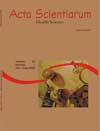<b>Prevalence of risk factors for cardiovascular diseases among people with hypertension enrolled in a family health unit</b> - DOI: 10.4025/actascihealthsci.v31i1.4492
Keywords:
cardiovascular diseases, risk factors, hypertension, cross-sectional studies
Abstract
Non-transmissible diseases, particularly cardiovascular diseases, have emerged as important causes of morbidity and mortality in Brazil, mainly in urban areas. Heredity, age, race, gender, high blood pressure and lipids, smoking, diabetes, obesity and physical inactivity are recognized risk factors for these events. This study aimed to estimate the prevalence of some risk factors for cardiovascular diseases among hypertensive patients aged 20 to 79 years who had been enrolled in a Health Family Unit in Londrina, Paraná State, Brazil. Data was collected during home interviews, with questions about demographic and socioeconomic aspects, lifestyle and health condition. Among the 385 interviewed patients, the following prevalence rates were observed: 28.6% of raised blood cholesterol; 16.9% of smoking; 5.5% of regular use of alcoholic beverages, 70.4% of physical inactivity; 22.9% of diabetes and 30.9% of family history of cardiovascular disease. A high prevalence of risk factors was observed, particularly physical inactivity. Adequate management of these risk factors with preventive and educative measures is essential to reduce cardiovascular complications in this group of hypertensive patients.Downloads
Download data is not yet available.
Published
2009-05-07
How to Cite
Girotto, E., Andrade, S. M. de, Cabrera, M. A. S., & Ridão, E. das G. (2009). <b>Prevalence of risk factors for cardiovascular diseases among people with hypertension enrolled in a family health unit</b> - DOI: 10.4025/actascihealthsci.v31i1.4492. Acta Scientiarum. Health Sciences, 31(1), 77-82. https://doi.org/10.4025/actascihealthsci.v31i1.4492
Issue
Section
Medicine
DECLARATION OF ORIGINALITY AND COPYRIGHTS
I Declare that current article is original and has not been submitted for publication, in part or in whole, to any other national or international journal.
The copyrights belong exclusively to the authors. Published content is licensed under Creative Commons Attribution 4.0 (CC BY 4.0) guidelines, which allows sharing (copy and distribution of the material in any medium or format) and adaptation (remix, transform, and build upon the material) for any purpose, even commercially, under the terms of attribution.
Read this link for further information on how to use CC BY 4.0 properly.























5.png)







